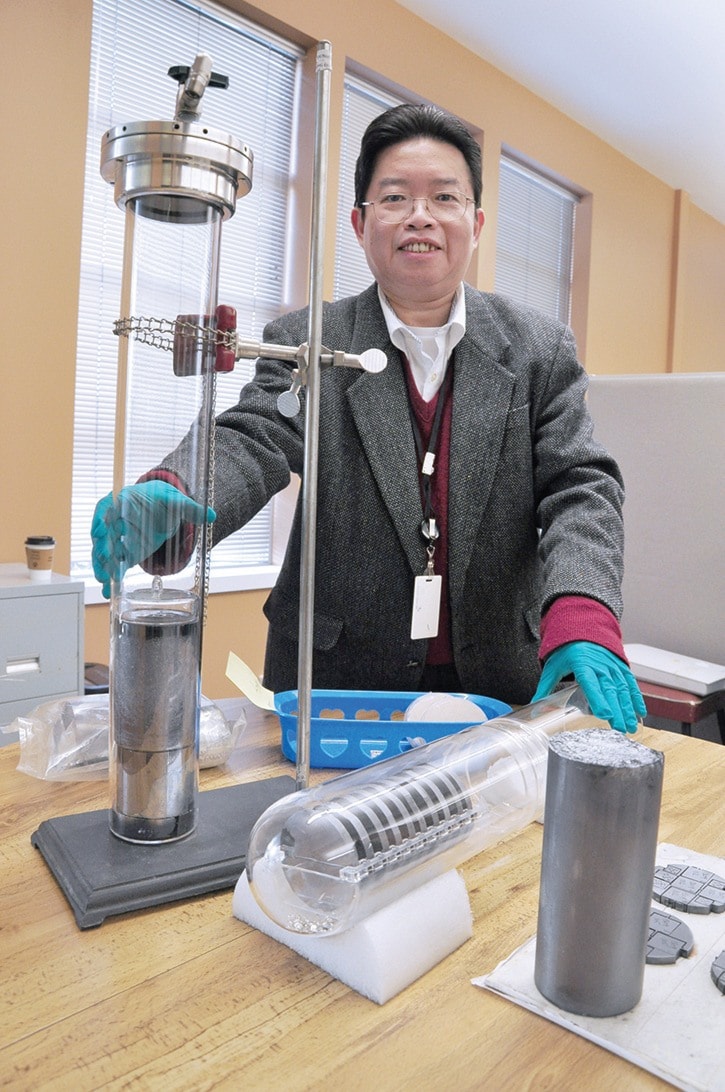Henry Chen holds in his hand a thick metallic cylinder of raw semiconductor crystal. The material’s manufacturing process is a tightly guarded industrial secret, and it lies at the heart of cutting-edge radiation detection technology.
Yet Chen is only half-joking when he refers to it as “kind of like a rock.” When he joined Redlen Technologies 10 years ago, the company was a small startup that grew semiconductor crystals out of a garage in Victoria.
The driven 47-year-old helped propel Redlen to one of four high-tech firms in the world designing and fabricating detectors now found in nuclear medicine, luggage scanning gear and satellites that probe the cosmos.
Chen recently received international recognition at a nuclear science symposium in Seoul, South Korea, for his 20 year effort in forging not only fundamental techniques behind growing ever bigger and better cadmium zinc telluride (CZT) crystals, but also integrating that semiconductor material into commercially useful devices. He was named room temperature semiconductor detector scientist of the year.
“The award means a great deal to me professionally and personally,” Chen said. “The best part is seeing the research being put into practice. (CZT) must be put into a useful device, or its kind of like a rock.”
Chen, who lives in Gordon Head with his wife and two kids, is the embodiment of the immigrant success story.
Gifted in physics and math, he moved to the U.S. from Taiwan about 30 years ago and paid his way through university by washing dishes and working “three jobs at a time.” He earned his undergrad and PhD in physics from University of Massachusetts.
He went to work for NASA in 1995 and started making breakthroughs in CZT semiconductor technology. It’s a field where bigger is better – when Chen started his work, the largest CZT crystals were less than the diameter of a thumbnail. These days they’re 10 cm across and thick, and extremely free of defects, thanks to proprietary techniques pioneered by Chen.
“Henry has made a huge contribution to the company over the years, particularly in the area of detection capability. He started the crystal growth part of the company,” said Jim Balcom, vice-president of operations for Redlen.
“Henry was instrumental in taking the company from a crystal growing company to an actual detection and fabrication company.”
Impressed with late Redlen founder Bob Redden’s crystal growing techniques, Chen joined the company in 2004 as a world authority on semiconductor crystals, and saw the opportunity to grow a company from the ground up. By that time, he had also earned an MBA.
“I had evaluated crystals grown all around the world. All others had hit a wall. Redlen made the breakthrough,” Chen said. “We changed a small R&D garage shop to a world class company. I shocked the world with Redlen’s crystal quality.
“I’m glad I’m able to contribute back through research. We are able to save lives through better medical diagnoses and help make the world a safer place to live.”
Now with roots in Victoria, Chen said he’s enjoying what Saanich has to offer in terms of quality of life, especially the recreation centres for his kids.
“I heard B.C. was one of the best places to live on earth. And Victoria was the capital and we decided to give it a try. Here we are 10 years later,” he said. “I’m happy I moved here.”
He remains a scientific advisor to Redlen, but these days is focusing his talents as the chief operating officer for Empire Hydrogen, in Sidney. Empire Hydrogen has devised a system that injects hydrogen into engines for a cleaner, more powerful internal combustion, which reduces emissions and increases efficiency.
“I understand the technical side and the business opportunities to make the science become a reality,” he said. “The research has got to have practical applications, or its just science fiction.”
editor@saanichnews.com
Did you know?
-Redlen Technologies’ technology can be found in radiation monitoring gear at the troubled Fukushima nuclear plant in Japan and was in hand-held “dirty bomb” detectors at the 2010 Vancouver Olympics.
-Now with 60 employees, about half are scientists and engineers, Redlen is looking to double its revenue this year to $8 million, and is shipping detectors for next-generation security, medical and scientific devices.
